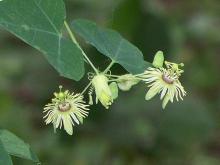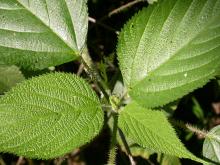Wildflowers, Grasses and Other Nonwoody Plants
Media

Species Types
Scientific Name
Ageratina altissima (formerly Eupatorium rugosum)
Description
White snakeroot looks very similar to thoroughworts, but it has triangular leaf blades that are more broadly angled or rounded at the base. White snakeroot is common statewide. It’s a toxic plant if eaten, so it’s good to be able to identify it.
Media

Species Types
Scientific Name
Polygonatum biflorum
Description
Solomon's seal grows statewide in moist, rich earth. The greenish-white flowers dangle like little bells beneath the leaves, under the gracefully arching stems.
Media

Species Types
Scientific Name
Dioscorea oppositifolia (sometimes called D. batatas)
Description
Similar to kudzu, Chinese yam is an aggressive vine that overtakes nearly everything within reach that stands still long enough! Learn more about this invasive plant — and please don’t plant it!
Media

Species Types
Scientific Name
Asclepias purpurascens
Description
The flowers of purple milkweed are pale purple to reddish purple to dark purple, with greenish or red tints. The scientific name means “becoming purple”: The flowers start off rather pale and become more intensely purplish as they mature.
Media

Species Types
Scientific Name
Phytolacca americana
Description
A tall, smooth, branching plant with red stems and juicy, dark purple berries, pokeweed is both toxic and a traditional edible potherb called poke salat. It is common statewide.
Media

Species Types
Scientific Name
Yucca smalliana, Y. glauca, and Y. arkansana
Description
Three species of yucca grow wild in Missouri. Spanish bayonet was introduced from the Southwest and has escaped from cultivation, but our two soapweeds are native.
Media

Species Types
Scientific Name
Passiflora lutea
Description
Yellow passion flower is the smaller of Missouri’s two Passiflora species. Both are vines that climb via tendrils. This one has yellowish-green flowers about an inch wide. Look for it along and south of the Missouri River.
Media

Species Types
Scientific Name
Ambrosia trifida
Description
Large stands of wind-pollinated giant ragweed commonly form in disturbed areas, causing late-summer misery in the form of hay fever for many Missourians.
Media

Species Types
Scientific Name
Fallopia scandens (formerly Polygonum scandens)
Description
Climbing false buckwheat is a rampant, native, annual or perennial climber that often forms curtainlike masses of twining red stems, covering shrubs and trees. Look for it in moist, open or shaded bottomlands, alluvial valleys, and floodplains.
Media

Species Types
Scientific Name
Laportea canadensis
Description
Wood nettle, or stinging nettle, often forms dense stands in bottomland forests, streamsides, and other places. There, canoeists, anglers, and others try to avoid touching its stinging hairs!
See Also
About Wildflowers, Grasses and Other Nonwoody Plants in Missouri
A very simple way of thinking about the green world is to divide the vascular plants into two groups: woody and nonwoody (or herbaceous). But this is an artificial division; many plant families include some species that are woody and some that are not. The diversity of nonwoody vascular plants is staggering! Think of all the ferns, grasses, sedges, lilies, peas, sunflowers, nightshades, milkweeds, mustards, mints, and mallows — weeds and wildflowers — and many more!





















